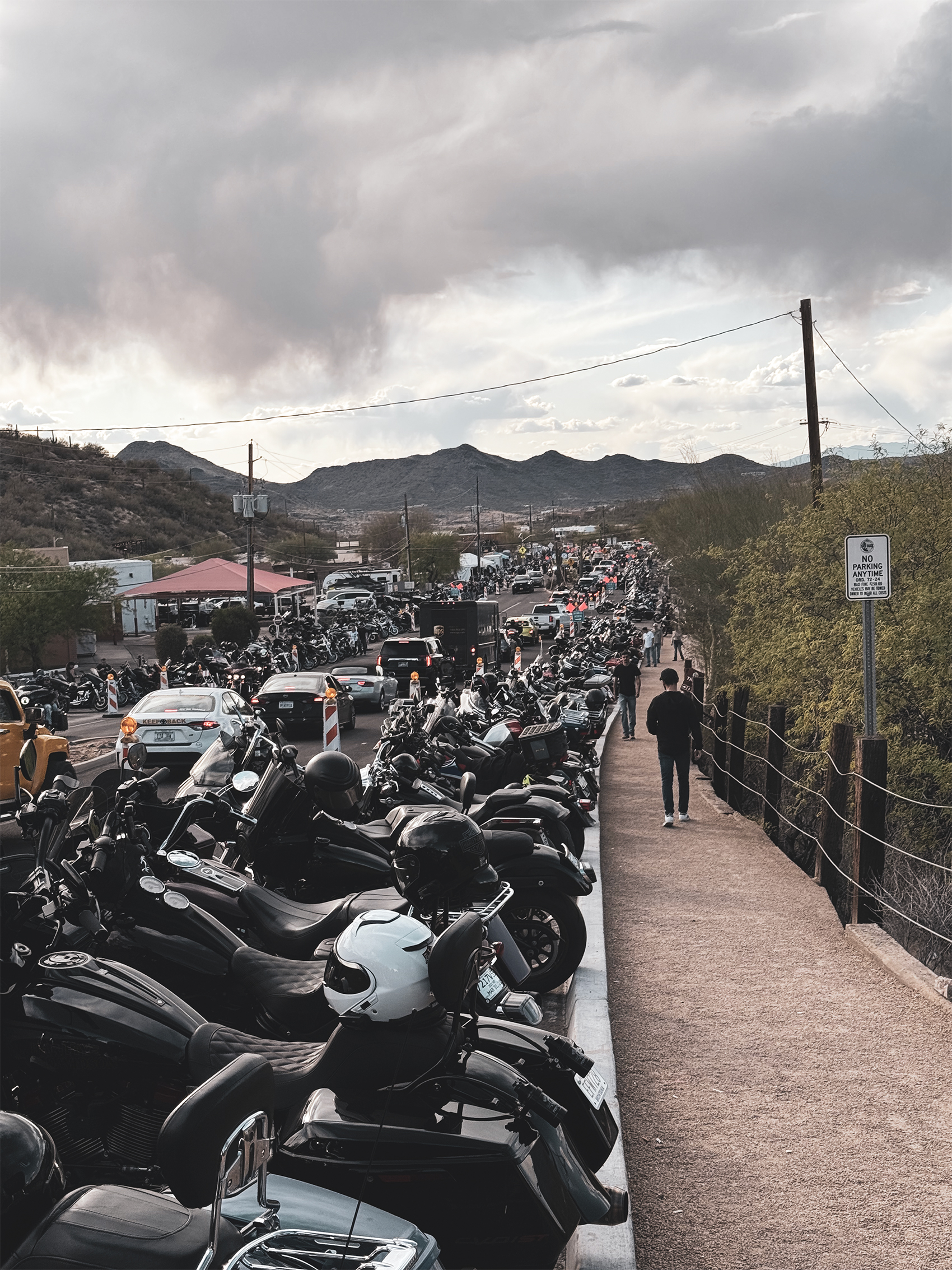Bike Week
by Tamara Martin Causey

It is my favorite time of the year in Arizona. We have the spring temperatures we’ve had all winter, but now we have the sounds of birds and the smell of new flowers. Our eyes and ears are also tuned in to the sight and sound of rattlesnakes. They fascinate me. If you get in their way, they’ll rear up and look at you and rattle with such a fierceness that you willingly give them the right of way. There is an order to things. And this is an order I gladly respect.
Springtime here brings another sound: the sound of 50,000 motorcycles moving in and out of town. With that many on a stretch of two miles, it’s a constant vibrating roar. There are so many, you cannot hear the typical start or stop or whether they’re nearby or far away. All you hear is the constant, steady white noise. It will be about two a.m. before the white-noise lull will give way to the doppler shift.
It’s bike week. For 27 years it has been a local tradition. It is our little Sturgis. The town becomes unrecognizable but in a way that feels like the “rebellious, no rules, party of the century is here to stay” feeling. Somehow this little town of 5,000 morphs into 70,000. It would be generous to say there’s standing room only in the local bars and streets. Year after year I have watched the visitors come and go. And year after year I didn’t notice the subtle changes. It wasn’t until this year that I felt the pivot point of a paradigm shift. The realization of what I was seeing struck me with such a force that I had to stand frozen in the middle of a sea of bodies and go inward to try to reclaim my composure, emotions, and balance.
I know there had to be signs all along, but my naked eye couldn’t see it until I saw it in plain writing on T-shirts and trinkets this year. There was no denying there was a disturbance, and the rattle was reverberating throughout the town and nation. I am now paying attention and watching.
For as long as I could remember, what came with bike week were professional bartenders in fishnet stockings and pasties. T-shirts with marijuana leaves or some rebellious symbol or quote that meant, “We rebel against the establishment, we don’t fit the status quo, we take care of our own, we are family, wild and free.” Sprinkled in were plenty of wet T-shirt contests and drinking shots from well-endowed bosoms to the sound of rock’n’roll. As strange as it sounds, it felt like the safest place on earth. Scattered within this massive crowd of visitors were my neighbors and friends. Each year even I enjoyed being a rebel for a week—until now.
This year the trinkets were different and I couldn’t take pleasure in being a rebel. This wasn’t playing; this was a real expression of years of anger and the resentment of not being heard. The pasties gave way to body paint of Trump’s head. There were stickers that said “Daddy’s Home” and pool floats with Trump’s head and the middle finger extended. The list goes on and on.
I needed help understanding this. Google came through for me just halfway. A quick search yielded some information. I found that bikers tend to be Trump supporters because they see Trump as a rebel against authority, a man who doesn’t fit in and a man who doesn’t always say the right things in the right way. They can identify with those characteristics. But I saw so much more. To leave it at that makes the biker culture seem shallow and non-thinking, which is not at all true. Walking down the street and reading the vendors’ merch tells a deeper, more tragic story that has not been noticed for years, but now the rage has exploded through the surface. It didn’t just happen in one year, but this is the year I noticed it. The pivot point of the rattle being loud enough to hear.
The T-shirt slogans are a walking testimony to the politics, anger and frustration that led to the current administration being in office:
“Working like crazy to support the lazy”
“Men in denim built this country, men in suits have destroyed it”
“You are entitled to nothing. You want it? Then earn it”
“All hustle, no handouts”
I witnessed at least five biker groups of five different ethnicities wearing the same Trump messages. Their clubs were segregated, but they all seemed to share the same values or to have felt the same struggles.
A big part of the group appeared to represent the ones in the middle, who make too much to benefit from most social programs but don’t make enough to live comfortably unless they hold second and third jobs. The more fortunate are the ones who can work overtime and make time-and-a-half most weeks. Fierce, independent survivors who live by the motto, “No one owes you shit. Work harder.” Yes, that was another T-shirt.
Someone heard the rattle but this time no one stepped away, so the strike position is still in place.
- Tamara Martin Causey, PhD, is a psychologist with a clinical practice in Arizona, where she has lived for the past 22 years. Having grown up in the South, her training and career, including teaching, practice, supervision, and crisis intervention, has brought her to the South, Southwest and the Northeast of the United States and allowed her to observe the regional and cultural differences of these areas. She currently finds herself in the unusual juxtaposition of living in a rural, mostly red area of a swing state while also serving as Arizona’s Council Representative to the American Psychological Association. In that role, she is continually aware of current policy changes and how they will affect the mental health of our most vulnerable populations. Her goal is to ask and reflect on the “why” questions in order to raise awareness and help people with opposite viewpoints understand each other.
- Email: drtammymc@gmail.com
ROOM is entirely dependent upon reader support. Please consider helping ROOM today with a tax-deductible donation. Any amount is deeply appreciated. |





